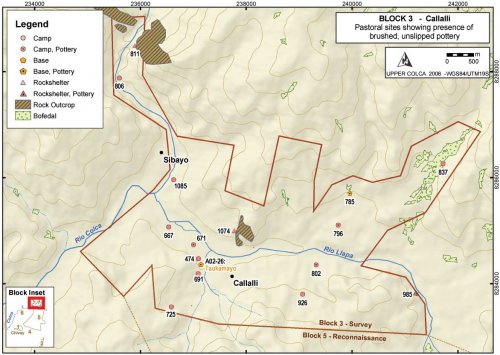6.4.3. Block 3 - Callalli
An Early Agropastoral period occupation of the Block 3 area is evident from survey work, but it is less dense than was encountered for this time period in Block 2, and it is also more faint than the evidence from the Late Prehispanic in this the Block 3 area itself.
Figure 6-61. Early Agropastoralist settlement in Block 3.
The Early Agropastoral settlement in the Callalli area is difficult to isolate from later pastoral settlement, but the evidence that was encountered suggests that it was a distributed settlement pattern with similarities to the pastoral pattern observed elsewhere in the higher altitude portion study area. The criteria used to discern this settlement pattern were sites with pastoral attributes (grazing lands, water), and the potentially the presence of the unslipped Chiquero type ceramics considered Formative in the main Colca valley by Wernke (2003).
Occupations are generally small and diffuse, with rock shelters and river terraces providing the majority of the settlement locations. The rock shelter of Quelkata [Q03-985], described in the preceding Archaic Foragers - Block 3 section, had a substantial a-ceramic occupation. However the vast majority of the projectile points analyzed by Chavez (1978) appear to fall into Series 5 in the Klink and Aldenderfer (2005) typology, placing the occupation in the Terminal Archaic. Elsewhere in Block 3, several multicomponent sites were occupied during this time period, most notably Taukamayo [A02-26].

